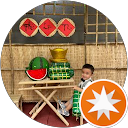Chen Kieu Pagoda (Chùa Sà Lôn): Discover Sóc Trăng's Artful Khmer Treasure
Chen Kieu Pagoda (Chùa Chén Kiểu), formally known by its Khmer name, Wath Sro Loun, offers visitors one of the most distinctive architectural experiences in the Mekong Delta. This pagoda draws attention not just for its deep spiritual significance to the Khmer people, but primarily for its unconventional and stunning decorative technique.
Address: GWQC+64G, QL1A, Đại Tâm, Mỹ Xuyên, Sóc Trăng, Vietnam.
I. History and Origin of the Unique Name
The pagoda was originally built in 1815, starting out as a simple structure made of wood and leaves. The temple has since undergone several reconstructions due to damage from war.
The Name “Sà Lôn”: The Khmer name Sro Loun comes from Chro Luong, the name of a canal that once ran near the temple. Locals simplified the pronunciation to Sà Lôn.
The Name “Chén Kiểu”: The temple received its more popular Vietnamese name, Chùa Chén Kiểu (“Bowl Pagoda”), during its major reconstruction in 1969. Because monks lacked sufficient construction materials, they encouraged the local community to donate used porcelain bowls and plates. Skilled artisans cleverly utilized these shards to affix them onto the walls, columns, and stupas, creating the pagoda’s signature mosaic patterns. This creative solution resulted in a stunning and unique architectural masterpiece.

II. Architectural and Cultural Highlights
The entire compound showcases the elaborate, colorful Khmer style, enhanced by its unconventional materials.
Porcelain Mosaics: The most captivating feature is the extensive use of porcelain. Guests can admire the intricate mosaics of bowls, plates, and ceramic pieces that adorn the exterior walls, towers, and columns of the Main Hall. These decorations depict delicate patterns and vibrant colors.
Khmer Mythology: Look closely at the temple grounds. The surrounding fence features dancing Apsara goddesses, symbolizing peace and prosperity. The main entrance is flanked by statues of the Kerno goddess, a mythical creature with the face of an Apsara and the body of the Garuda bird, representing both beauty and power.
The Main Hall (Chánh Điện): Inside the spacious hall, you find a solemn atmosphere. The hall exclusively honors the Shakyamuni Buddha. Paintings on the walls illustrate the life of the Buddha, from birth to enlightenment. Additionally, the temple preserves ancient scriptures written on palm leaves.
The Buddha Garden: Behind the main structure lies a peaceful garden that features many statues depicting key moments in the Buddha’s life.

III. Visitor Information and Etiquette
Chen Kieu Pagoda is conveniently located right off National Highway 1A.
Entrance Fee (Giá vé): The pagoda typically does not charge an admission fee for entrance, adhering to the tradition of spiritual sites. However, visitors may offer voluntary donations (tiền công đức) to support the temple’s maintenance.
Operating Hours (Giờ mở cửa): The pagoda is open every day from dawn to dusk.
Location: The temple is situated approximately 12 km from Sóc Trăng City center, making it an easy stop on the route between Sóc Trăng and Bạc Liêu.
Attire: Remember to dress modestly, ensuring shoulders and knees are covered, to respect the sacred nature of the site. Always ask the monks for permission before taking photographs in sensitive areas or during prayer.




